#darlinghurst theatre
Text

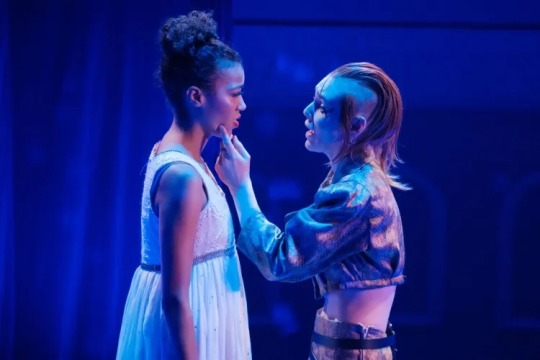

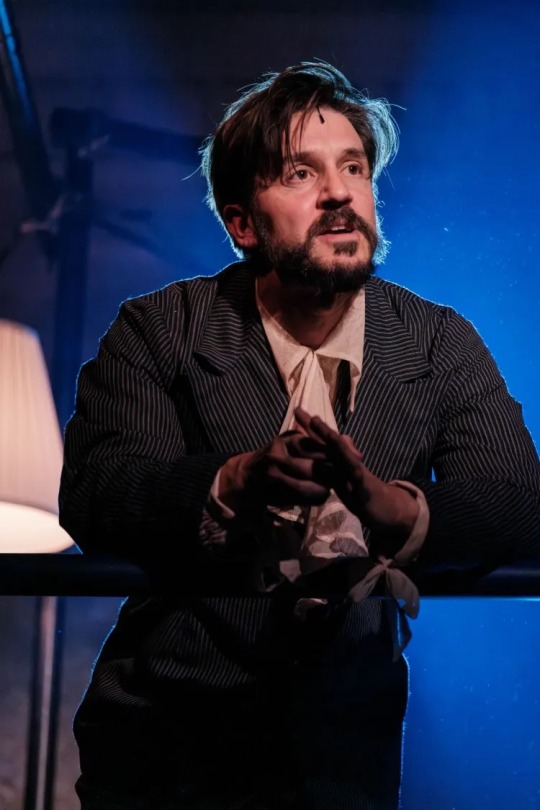

babe wake up great comet australia photos just dropped (credit: robert catto)
#ngl the stage looks a bit sparse but whatever#absolutely in love with natasha and sonya’s dresses#anatole being a queer nonbinary drag king who plays clarinet is literally all I have ever wanted#great comet#natasha pierre and the great comet of 1812#natasha rostova#pierre bezukhov#anatole kuragin#sonya rostova#darlinghurst theatre company
387 notes
·
View notes
Text
my initial review of the darlinghurst theatre production of The Great Comet of 1812 is that it was a beautiful queer salve to the wounds I sustained from the 2017 tonys .
also not to be like 'wow this media is better when the actor is hot to me, personally' but phew .

they were VERY hot .
#i love . musical theatre . i love darlinghurst too apparently !! thanks for being there . i love you all so much mwah#.txt#the great comet of 1812#tgc#the great comet aus
13 notes
·
View notes
Text
Natasha, Pierre & the Great Comet of 1812 - Eternity Playhouse Sydney 23.08.2023
Natasha, Pierre & the Great Comet of 1812 - Eternity Playhouse Sydney 23.08.2023 #electropopopera #musical #warandpeace #leotolstoi #entdeckung #thegreatcomet #australien
Es ist schon einige Jahre her, seit “Natasha, Pierre & the Great Comet of 1812” seine Off-Broadway-Premiere im Jahr 2012 erlebte und 2016 für ein Jahr an den Broadway ging. Nun also eine kleine und sehr feine Produktion in hervorragender Besetzung am Eternity Playhouse in Sydney, es ist die australische Erstaufführung dieses Werkes..
Continue reading Untitled
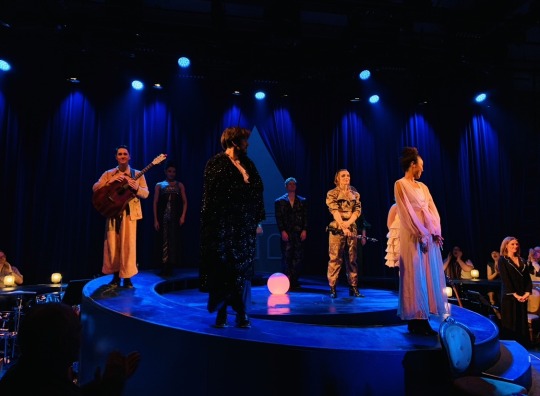
View On WordPress
#Australien#Brendan Yeates#Broadway#Claire Healy#Darlinghurst Theatre Company#David Malloy#Dean Drieberg#Electro Pop Opera#Eternity Playhouse#Grace Driscoll#Jillian O&039;Dowd#Jules Pendrith#Krieg und Frieden#Kritik#Leo Tolstoi#Musical#Musik#Natasha Pierre & the great Comet of 1812#Off Broadway#Rezension#Russland#Sydney#The Great Comet#War and Peace#Zoo Frangos
2 notes
·
View notes
Text
literally so fucked up that the great comet is making its australian premiere in new south wales instead of where i specifically live.
#omens#it's being put on by the darlinghurst theatre company and previews just ended i think.#AUGH I WANT TO SEE IT. i've only seen production photos but from what i can see i love the set and the lighting and the costumes <3#from what i can tell it's very scaled back (just a raised circular platform in the center with seats around) so it seems like it's pretty#minimalist which i like <3 personally <3 i like minimalist sets i like that you can do so much with so little <3#apparently they change from blue to red lighting from act 1 to act 2 which is cool <3 Symbolism baybee <3#i also love that one dress natasha wears with the big puffy sleeves it looks good i like it <3#i've also heard good things about their sonya (kala gare) and marya (jillian o'dowd)#and i know that anatole is played by a drag king (jules pendrith / johnny gash)#AND THEIR NATASHA (grace driscoll) LOOKS SO FUCKING GOOD!!!!!!!! GOD!!!!!!!!!!!!!!!!!!!!#GOD. PAIN. AGONY EVEN.#what i'm saying is. they should let me see it. all expenses covered. <3
4 notes
·
View notes
Text



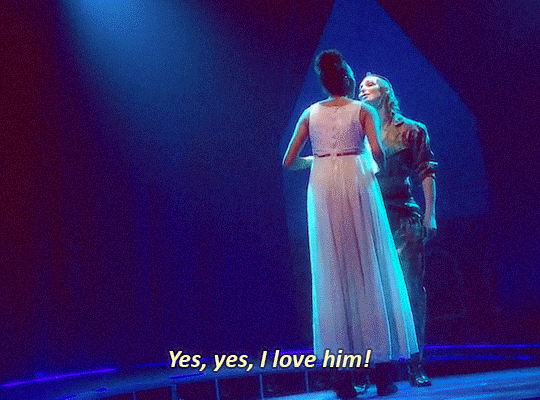

grace driscoll as natasha and jules pendrith as anatole / natasha, pierre and the great comet of 1812, darlinghurst theatre company
master: serarichu
#natasha pierre and the great comet of 1812#great comet#grace driscoll#jules pendrith#great comet aus#great comet australia#natasha rostova#anatole kuragin#musicals#musicaledit#musicalgifs#theatreedit#musicaltheateredit#musicaltheatreedit#carmella's edits#descriptions in alt text#this anatole-natasha combo? i think i hauve couvid (this is funny because i do currently have cov*d)
1K notes
·
View notes
Text









I can't fucking wait to see Darlinghurst Theatre's Natasha, Pierre, and the Great Comet of 1812 next week 👀
#Natasha Pierre and the Great Comet of 1812#Great Comet#Dave Malloy#I am looking directly at the costumes and specifically Anatole 👀
49 notes
·
View notes
Text
ok so i'm back, i've slept on it, here are some things i loved about the darlinghurst great comet (in no particular order - spoilers if you want to be surprised by the creative decisions):
the drinks were great, i don't drink so i had the war and peach at the intermission and it had glitter in it!! btw just in general love when theatres change the name of a drink for the show ('anatole spritz' (aperol spritz) tickled me)
everyone was so kind, i got complimented on my outfit and the person (usher? idk the word) was really helpful
the building was accessible in a way i wasn't used to. the accessible bathroom had those buttons to open and lock the door, idk whether the changing place was adequate for adults but it was there. there was a lift between the upper and lower ground floor so i could actually go down those half floor stairs that i usually just have to sit at the top of
the use of the (massive) disco ball was beautiful, i started crying during no one else and the little specks of light spinning like snow were a contributing factor in that
the costumes!!!! they definitely did their own thing with them. natasha's opening dress with the sleeves and anatole's crop top were highlights but the whole thing was cool. most of the fem clothes had a sort of babydoll vibe to them?? idk how to describe it.
sonya alone was beautiful, many of the solos (notably also pierre and dust and ashes) were performed as if the character was writing/singing a song rather than the actor performing the characters' thoughts, if that makes sense?? but just the spotlight on her, her playing the piano and singing..... it wasn't what i was expecting, but it allowed a nice little rest between bigger numbers and let me focus on the singing
the whole cast was so talented though, i think every actor played an instrument at some point which is super impressive. some of them had cellos strapped to them half the time and were still dancing.
the theatre was so small that i'm pretty sure the cast could fully see me sobbing in the back row at the end. that is how great comet should be.
the jumping skills were impressive. not just during the abduction but also when people were getting off the stage.
i like how opb's movements were mostly controlled by other actors dragging his clothes around. my dad and i had a conversation about whether it's symbolic of his privilege (having a bunch of yes man servants) or of his declining mental state (being controlled by his dementia (?) instead of what he used to be)
danatole rights in the duel and preparations (they are so dysfunctional <3). anatole grabbing at dolokhov's chest and kissing his neck when 'a fact known only to his intimates' *chefs kiss*
marya's actor wasn't performing and the swing was playing helene so the production manager (?) was playing marya. given that she didn't know the role perfectly (she had the script in hand) she did really well!!!!
the 2 little balconies were great, they added a lot of dimension to the stage. (for those wondering, to my memory the songs performed in the balconies were: pierre, natasha and sonya in the opera, natasha & anatole, dust and ashes, pierre in letters, preparations, anatole in find anatole, and pierre & anatole)
GENDERQUEER ANATOLE!!!!! the way they would switch octaves mid line <3333
actually multiple of these actors are trans/gnc!!!!!!!
there was no/very little ensemble so you could hear every individual voice during the harmonies
the program is gorgeous, there are little glossy constellations all over it which makes a nice texture
the choreography in charming was so neat. love those little shoulder wiggles.
no strobing in the duel (but yes strobing in the opera when anatole comes in)
they did something with the lighting during the ball kiss that sort of made it look like a veil of light and a little strip of darkness spinning around them. if i'm going to analyse it conveys natasha's confusion while giving her privacy. or something i can't figure out the words to explain it.
not really intentional but right before the bit of the opera with the show, they stopped the performance for a bit. idk why. but it was charming and helpful for me because i had to ground a bit.
i cried 7 times. my head hurt by the end of it.
the use of silence was so good. like pauses between songs, in the middle of them, idk just. you know that post about how live theatre conveys loneliness better than anything else? yeah.
i know i already said this but i kept putting these as separate points so i'll just say all the actors' performances are SO GOOD. natasha and sonya were like..... scarily well cast btw
the 'no, i am enjoying myself at home this evening' line was performed so well
i didn't get an on stage seat but they were sitting at a long table type thing that was actually part of the stage and the cast were literally dancing directly in front of them
i like the fact they didn't try to find gender conforming audience members to bring up (in this performance, mary's suitor was fem presenting and opb's 'cheap french thing' was masc presenting). they didn't change pronouns to try and match the gender presentation of whoever they called up. same with the actors during the abduction (matryoshka etc).
finally managed to id the woodwind instrument in the 'he'll come home one day and take me away, i want nothing more' bit ('twas a clarinet). that was bugging me for years.
the comet was depicted by natasha's actor holding a big lit up ball and slowly walking through the mid-audience bit of the stage. when the song ends she gives it to pierre and he holds it until it's the only light in the room. something something hope.
they didn't directly copy the recording, there were variations in the tune that caught me off guard (in a good way) and they pronounced things the way that was most natural for an australian performance instead of trying to americanise.
overall, the only thing i would want for is to have a recording for sale, because my memory is so shit that i remember something that happened yesterday about as well as i can remember being 4 years old (not an exaggeration). i'm sort of sad that i can't see it again and again, which is just part of ~the magic of theatre~ but also a sign that it's really that good.
(anyway i highly recommend it if you're in sydney before the 20th of august)
#(btw im not anywhere near there now dw)#great comet#natasha pierre and the great comet of 1812#alcohol ment#good post op
28 notes
·
View notes
Text
Godtet +Strings - dub jazz goes cinematic with the addition of a sting quartet
Recorded live in concert with an acoustic string quartet in a colonial-era gaol during VIVID Festival in Sydney 2022.
GODTET is:
GODRIGUEZ: guitar. ANDREW BRUCE: keys. DOMINIC KIRK: percussion. JAN BANGMA: bass. TULLY RYAN: drums.
Strings:
Novak Manojlovic: Composer, conductor, additional synthesiser. Jack Ward: Cello. Phoebe Gilbert: Viola. Lydia Sawires: Violin. James Armstrong: Violin.
Auxiliary live effects and soundscape: JACK PREST
Recorded live in concert at Cell Block Theatre, National Art School, Darlinghurst, on June 1st 2022
Photo: TOM WILKINSON
Design & Lettering: LUKE EBERT
3 notes
·
View notes
Text
AUSTRALIAN MALLOY FANS RISE!!! COMET IS COMING TO THE DARLINGHURST THEATRE COMPANY!!!!! I CRIED WHEN I FOUND OUT NOW I JUST HAVE TO CONVINCE MY PARENTS TO TAKE ME TO SYDNEY LMAO
7 notes
·
View notes
Text
'Fourteen': Queer play is coming to Adelaide
New Post has been published on https://qnews.com.au/fourteen-queer-play-is-coming-to-adelaide/
'Fourteen': Queer play is coming to Adelaide

Acclaimed Australian gay coming-of-age play Fourteen is coming to Adelaide this August.
Fourteen is the stage adaptation of writer Shannon Molloy’s memoir about growing up gay in Yeppoon in central Queensland in the 1990s.
In Fourteen, the high school student struggles to get through a year of self-discovery at his sports-mad, homophobic Catholic school.
Shannon is tormented not just by his peers, but also by the adults who are meant to protect him.
However, this moving coming-of-age story is also a story of resilience, hope and hilarity – thanks to the love of a group of close-knit friends, a fiercely protective family, an extraordinary mother and… S Club 7.
Fourteen is filled with 90s pop culture references
Artistic Director Ross Balbuziente described Fourteen as striking “a delicate balance between trauma and tribulation and the humour and heart that ultimately triumphed.”
“We owed it to Shannon – and anybody else whose experiences mirror his – not to shy away from the more triggering moments and challenging themes,” he said.
“But we also wanted to show the absolute power friendship and family can have on a 14-year-old.
“The production stays true to the era of Fourteen. It features plenty of ‘90s pop culture references and a mixtape of bangers from Shania Twain to J.Lo.”
youtube
Event Details
Dates: Wednesday, August 7 at 7pm, Friday, August 9 at 7pm, and Saturday, August 10 at 2:30pm.
Location: Dunstan Playhouse, Adelaide Festival Centre
Ages: 14 and up
For the latest LGBTIQA+ Sister Girl and Brother Boy news, entertainment, community stories in Australia, visit qnews.com.au. Check out our latest magazines or find us on Facebook, Twitter, Instagram and YouTube.
In Other News:
Review: ‘Fourteen’ at QPAC is an unflinching gay coming-of-age story
Darlinghurst Theatre goes into Voluntary Administration
Qtopia announces The Loading Dock theatre season
0 notes
Text
SLNSW
Papers of Christopher Allen
Mick Glasheen interview
bush video https://collection.sl.nsw.gov.au/record/1Dr2axR9
confests https://collection.sl.nsw.gov.au/record/nM7l48xY
cell block theatre
new theatre Newtown/Darlinghurst
yellow house https://collection.sl.nsw.gov.au/record/74Vv8BeqWpbM
Roger Foley interview https://collection.sl.nsw.gov.au/record/9ALZz8oY
0 notes
Photo




New pictures of Darren performing in Sydney, May 17 2018.
Photos: AnnaRiots, used with permission.
18 notes
·
View notes
Text
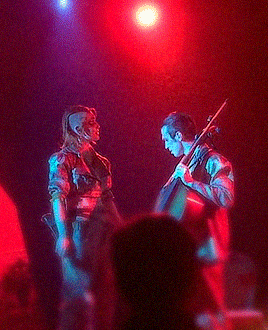
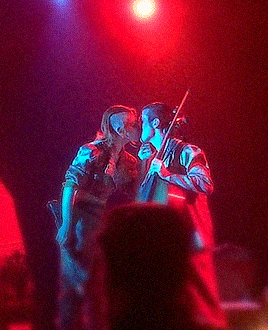
jules pendrith as anatole and cameron bajraktarevic-hayward as dolokhov / natasha, pierre and the great comet of 1812, darlinghurst theatre company
master: serarichu
#natasha pierre and the great comet of 1812#great comet#great comet aus#great comet australia#jules pendrith#cameron bajraktarevic-hayward#anatole kuragin#fedya dolokhov#musicals#musicaledit#musicalgifs#theatreedit#musicaltheatreedit#musicaltheateredit#theateredit#carmella's edits#descriptions in alt tags
139 notes
·
View notes
Photo

Finito ❤️ • • • • #theatre #stagemanager #stagemanagement #eternityplayhouse #darlinghursttheatre #darlinghursttheatrecompany #arts #performingarts #closingnight #closed #russiantransport #darlinghurst #sun #sunflare #heritage #heritagebuilding #pretty #nofilter #latergram (at Eternity Playhouse) https://www.instagram.com/p/BvsfbnlnZPU/?utm_source=ig_tumblr_share&igshid=19fai0bfx9w6z
#theatre#stagemanager#stagemanagement#eternityplayhouse#darlinghursttheatre#darlinghursttheatrecompany#arts#performingarts#closingnight#closed#russiantransport#darlinghurst#sun#sunflare#heritage#heritagebuilding#pretty#nofilter#latergram
1 note
·
View note
Text
Lesbian Socialising in 1940s-50s Sydney
Selection from Unnamed Desires: A Sydney Lesbian History, Rebecca Jennings, 2015.
Much of the international literature in the history of lesbian social practices has prioritised commercial spaces such as bars and nightclubs, suggesting that these venues represented the international standard of lesbian socialising in this period. Focusing primarily on large British and American cities, historians have charted the emergence of developed commercial lesbian subcultures after the Second World War.[4] However, the lesbian social scene in Sydney in the immediate postwar decades differs significantly from the subcultural patterns described in these accounts and complicates the accepted picture in a number of interesting ways. Available oral history evidence suggests that lesbians only appeared on Sydney’s camp social scene--as the early lesbian and gay bar culture was known--in significant numbers in the early 1960s, when they began frequenting bars and cabaret clubs alongside camp men. Prior to this, much of the evidence points to a unique lesbian scene in Sydney, centred on private networks meeting at house parties and later in social groups. The predominance of private rather than public patterns of socialising in the immediate postwar decades had a lasting impact on the development of lesbian social practices and subcultural identities throughout the period being explored. Individual women’s use of both public and private space was shaped in a variety of ways by behavioural norms defined in these private social spheres. Moreover, given that, as Elizabeth Kennedy and Madeline Davis claim, ‘community is key to the development of twentieth-century lesbian identity and consciousness’, these spatial practices also had a significant impact on notions of lesbian identity in the city.[5] [...]
Lesbian socialising in the 1940s and 1950s
Evidence of a lesbian commercial bar scene in Sydney piror to the 1960s is scarce and seems to point to a limited lesbian presence within a larger, predominantly male, camp scene. A small number of camp men recall occasional pre-1960 encounters with lesbians on the commercial camp scene. Dennis, who frequented the camp male venue Rainard’s Restaurant on King Street in the CBD in 1950s, believed that the two women owners were lesbians. He recalled:
“Rainards was another place we used to go, too, and that was run by, looking back now, two gay women. It was down in, appropriately, in the Queens Club, downstairs. And there was a Hungarian countess that was on hard times with a black cat playing the piano.”[6]
Another narrator suggested that the attendants to the drag queens at the grand artists’ balls of the 1950s were lesbians in drag. Some lesbians also mingled with the bohemian underworld of Kings Cross in the 195s, socialising in cafes and hotels with artists, camp men and Eastern European migrants. In 1955, the sensationalist tabloid newspaper, the Truth, claimed:
“Police told Truth this week that dozens of mannishly-dressed lesbian couples can be seen in Darlinghurst Rd., King’s Cross, every afternoon and night. They live as married couples--’husband’ and ‘wife’ and practise their disgusting perversions in secret. Something, however, they break out. Recently there was a fierce brawl in the lounge of a fashionable King’s Cross hotel. Two female perverts fought bitterly over the favors of a third woman.”[7]
Such descriptions suggest that a small number of ‘mannish’ or tough lesbians, some of whom where known to the police for minor offences such as brawling, vagrancy and indecent language, enjoyed a presence on the bohemian and camp male scene in the 1950s. However, oral history interviews with women who were attracted to other women in this period demonstrate that many women were not aware of the existence of commercial camp venues in the 1940s and 1950s and did not frequent them. [...]
Research into lesbian bars and commercial venues outside Australia has shown that lesbian bar scenes had become established in many American and British cities by the 1940s. [...] However, these large metropolitan centres may not be representative of a broader international trend--lesbian social practices in smaller cities and non-urban areas undoubtedly differed significantly from this model. While London and New York both had populations in excess of eight million in 1948, Australia’s two largest cities, Sydney and Melbourne, recorded populations of 1,484,004 and 1,226,409 respectively (in 1947).[11] Lucy Chesser’s work on Melbourne subcultures in the 1960s suggests that these population differences had a significant impact on the nature of lesbian socialising in Australia and that a lesbian commercial scene was only beginning to develop in Melbourne in the late 1960s. [...] Prior to this, Chesser claims, the only venues available to lesbians were a coffee shop in the city centre, which operated in various locations in the 1950s and 1960s, and a small number of predominantly male, heterosexual hotels (public houses), in which lesbians were tolerated on Saturday afternoons.[13] This pattern reflected that in Sydney, where a lesbian presence was rarely noted on the camp scene in the 1950s or earlier and women only began to join a mixed camp bar culture in significant numbers in the 1960s.
While the emergence of a commercial scene in the UK and US in the decades after the war in part reflected the growing social acceptability of public drinking for women, postwar Sydney was notable for its restrictive female public drinking culture and this also impacted on the nature of the lesbian scene in the city. Licensing laws in place in New South Wales from the First World War until 1957 enforced six o’clock closing of public bars, and these had a significant impact on gendered conventions of public drinking. Legislation explicitly prohibited women from drinking in public bars, confining them to separate saloon bars or ‘ladies’ lounges’. As the restrictive licensing hours began to have an influence on drinking habits, publicans increasingly adapted the layout of their premises to accommodate the large numbers of men who frequented bars for high-intensity drinking between five and six in the evening. The ‘six o’clock swill’, as it became known, required long bars and large areas of standing room to enable crowds of male patrons to fit into the bar and order drinks quickly. In this postwar drinking culture, saloon bars were increasingly sidelined and the practice of drinking in hotels became a highly masculinised pursuit.[14] While lounge or saloon bars continued to accept women patrons in some hotels in the 1940s and 1950s, cultural assumptions about hotels as masculine spaces rendered hotel lounges largely unacceptable for the majority of women and those who did frequent them were regarded as ‘rough’ and unfeminine. It was not until the reform of licensing laws in 1957 that the prohibition on women drinking in public bars was lifted and hotels began to be designed to accommodate mixed drinking in pub lounges. In the meantime, however, the cultural coding of hotels as masculine spaces had become firmly embedded in social norms and women found themselves unwelcome in bars for decades after the legislative change.[15]
Lesbian socialising in Sydney was therefore primarily located in alternative sites in this period, reflecting broader gendered leisure practices in postwar Australia. Same-sex attracted women forged private friendship networks centred on sports clubs, work in occupations such as the army, and artistic circles based around theatres and musicians, and in this period it was these patterns of socialising which dominated the lesbian social scene in Sydney.[16] Beverley and Georgina, who met in the years after the Second World War, recalled a diverse social life in the 1940s and 1950s. The couple met at a picnic organised by a mutual friend and, after building a network of about eight or nine lesbian friends, socialised at picnics, tennis clubs and each other’s houses. The women would also go on holiday together, staying in motels or renting an old shack on the Central Coast. In addition to this circle, they were part of a mixed camp social scene. Georgina recalled that they socialised ‘with the boys as well, the boys were all in, we knew a lot of the boys, a lot of them. We used to go to their parties and everything else, because we were always very friendly with the boys.’[17] Other sources also suggest that house parties provided an important and long-standing alternative to the bar scene for lesbians in the immediate postwar period. In his semi-autobiographical novel At the Cross, Jon Rose describes a camp party at Potts Point in Sydney’s eastern suburbs during the Second World War, at which lesbian painters and actresses mixed with drag queens and camp window-dressers.[18] Large-scale house parties on long weekends such as the Queen’s Birthday weekend were an aspect of the male camp scene in the late 1950s and early 1960s and it is clear that some lesbians attended these.[19]
The importance of friendship networks and the difficulties for women in socialising in a public bar scene suggest that house parties and outdoor activities may have been central to the lesbian social scene in Sydney in the immediate postwar decades. This tendency to socialise in small networks of friends, rather than as members of a larger lesbian community, shaped the models of identity developing in Sydney. Small private friendship circles tended not to evolve rigid rules of image and behaviour to which newcomers were expected to conform. Instead, women who socialised with circles of lesbian friends in this period typically describe themselves as ‘discreet’ and conforming to wider societal norms. Margaret, who went out to restaurants with her girlfriend in the late 1950s, described their appearance as ‘nice, well-dressed secretaries’ and herself as ‘like some respectable housewife’, while Rae, who worked in the city, recalled that she and her friends socialised in dresses, hats and gloves.[20] Coral also remembered that, in the late 1950s, she and her girlfriend: ‘Didn’t wear trousers or anything like that, of course, dressed very, very nicely’ at the mixed house parties they attended.[21] There was limited interaction between different friendship circles in this period, when it was often extremely difficult to locate other lesbians, and there was therefore little opportunity for the development of a larger, collective lesbian identity or subculture.
22 notes
·
View notes
Link
”Pantera Press has acquired ANZ rights for It’s All an Act, the debut memoir by Shane Jenek – the performer behind drag queen superstar Courtney Act – via Wendy Richards at Working Management.
Boy, girl, artist, advocate: Courtney Act is more than just the sum of her parts.
In 2003, Courtney broke out of the box in the premiere season of Australian Idol before signing to Sony/BMG. Ten years later, Courtney Act went global. In 2014, she was one of the Top 3 performers in Season 6 of the Emmy Award-winning RuPaul’s Drag Race, gaining a legion of new fans around the world. Courtney has since taken on a number of controversial social causes and stories, most notably in her political series American Act on Junkee.com which garnered over 6 million views.
2017 saw Courtney embark on a sold-out world tour with her original show, The Girl From Oz, which played at the Edinburgh Festival Fringe to 5-star reviews. Courtney gained new fans and followers during her winning stint on Celebrity Big Brother UK, where she educated viewers on queer issues including gender identity and fluidity, sexuality, same-sex marriage and more. She then made television history as host of the UK’s first bisexual dating show, E!’s The Bi Life. Courtney’s latest live show FLUID debuted at The Darlinghurst Theatre in February 2019.
It’s All an Act is a ground-breaking memoir that will give readers an intensely personal account of Shane Jenek’s experience growing into a proud, passionate, politically active, genderfluid, queer Australian icon – all while the world watches on.
‘Courtney Act is one of the most dynamic figures of our time, and we are beyond thrilled to be publishing this utterly charming, often emotional and always thought-provoking memoir about identity, gender, love and life. It’s All an Act will make you laugh, cry, think and feel more at peace with the person you are.’
– Lex Hirst, Publisher
‘I’ve always loved memoirs and autobiographies. I love hearing other people’s stories because I learn so much and grow in empathy. I’m so excited and honoured to put my story on paper. I couldn’t think of a better partner than Pantera Press for this project.’
– Shane Jenek, author
It’s All an Act will be released in February 2021.”
Press release for Courtney’s book, It’s All an Act - March 17, 2020
1 note
·
View note